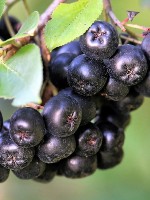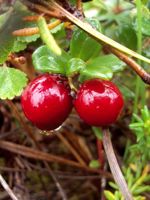Mon-Fri 9am - 5pm Mountain time
Viking Aronia Berry vs Small Cranberry
Aronia melanocarpa Viking
Vaccinium oxycoccos
NOT AVAILABLE THIS SEASON - MIGHT RETURN
CUSTOM GROW
Viking Aronia Berry is easy to grow, with black berries that are high in antioxidants. The Viking variety is much more productive than the non cultivar Aronia Berry. The berries can be eaten fresh but are found to be tart and bitter. They are more often used in baking, jams, juices, and wine. They have small, white flowers with a hint of pink that grow evenly on the shrub. The summer foliage turns a very attractive red in the fall.
The Viking Aronia Berry is a self-pollinating plant. Because of its uniformity and high yield, the Viking Aronia Berry is a popular cultivar.
Small Cranberry is a native evergreen groundcover found in bogs, fens, and wet meadows. It produces delicate pink flowers that attract a variety of pollinators, including bees, and it serves as both a nectar source and host plant for the Bog Fritillary (Boloria eunomia) butterfly. By late summer, the plant bears deep red berries that are eaten by both wildlife and people. With their high pectin content, the berries are well-suited for making jams and jellies.
Often creeping among sphagnum moss, Small Cranberry thrives in cold, acidic, and nutrient-poor soils (pH 2.9–4.7), making it well adapted to northern wetland environments. With its woody stems, it is technically classified as a shrub and often described as a subshrub or dwarf shrub. It is also valuable for wetland restoration and naturalisation projects.
Note: We use Small Cranberry for Vaccinium oxycoccos. This species is also known by many other common names, including Bog Cranberry, Small Bog Cranberry, and others. Please confirm the scientific name to ensure you are ordering the correct plant.

